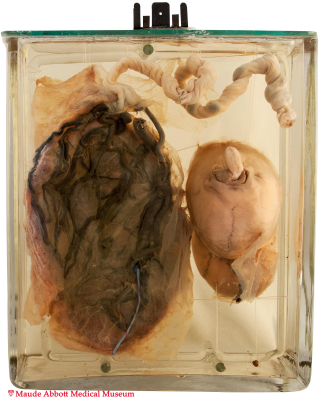

Enlarge
Donor: Dr. Plulau, Montreal Maternity Hospital
Date: 1914
Size (H x W x D cm): 26 x 22 x 12
A normal placenta with attached umbilical cord is seen on the left. Next to it is a markedly malformed fetus, consisting almost entirely of a “head”; no heart was identified.
History: Twenty-one year-old, para 3; triplet pregnancy.
Comment: The condition is more commonly termed the “twin reversed arterial perfusion (TRAP) syndrome”. It occurs in about 1 in 30,000 pregnancies overall and about 1% of monochorionic twin pregnancies. It is characterised by a normal (“pump”) twin and a twin without a functioning heart (“acardiac”), each connected to a single placenta. The “pump” twin provides blood flow to the affected twin via vascular anatamoses. Deoxygenated blood from the acardiac twin returns to the placenta via its umbilical vein and through venous anastomoses traverses to the normal pump twin. Because of increased cardiac flow, the pump twin can develop heart failure.
The cause of the abnormality is not certain. One theory posits a primary developmental abnormality of the fetal heart with secondary dysgenesis of other body parts. A second (and more widely believed) explanation considers the primary event to be development of placental vascular anastomoses with secondary reversal of blood flow from the normal to the abnormal twin. Depending on the specific anastamoses formed, there may be mal-development of the lower limbs, abdomen, thorax and/or head.
CLASSIFICATION OF ACARDIAC FETUSES
Acardius amorphus The least differentiated form, in which only bones, cartilage, muscle, fat, and blood vessels are seen. If rudimentary nerve tissue is present, it is called acardius myelantencephalus.
Acardius acormus This form lacks a thorax, with the umbilical cord insertion in the head. Despite the absent heart, rudiments of thoracic structures are often found.
Acardius acephalus The most common form, with absence of the head, thorax and upper extremities.
Acardius anceps These fetuses have a head, thorax and abdominal organs but lack a heart.
Modified from: Bonilla-Musoles F, Machado LE, Raga F, Osborne NG. Fetus Acardius: Two and Three dimensional ultrasonographic diagnoses. J Ultrasound Med 20:117-1127, 2001